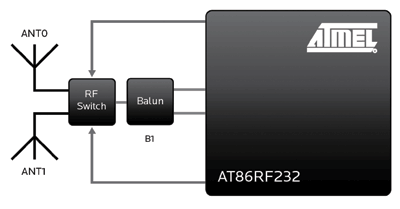Remote controls: no longer a one-way interaction
BY MAGNUS PEDERSEN
Director AVR Marketing, Atmel
www.atmel.com
The humble TV remote control has provided us with a convenient, yet unengaging, means of setting our televisions and AV equipment for tens of years. The infrared remote has changed little in that time despite the controlled technology making immense leaps. However, tidy away your hi-fi inside a wooden cabinet and you loose control.
Conceived in July 2009, a wireless-based approach using ZigBee was promoted with the introduction of the RF4CE application layer standard. Based on IEEE 802.15.4, the approach eliminates all of the traditional obstacles such as the line-of-sight barrier, distance limitations, and the lack of feedback to the remote control. Making a two-way control, allowing a more intuitive and comprehensive user experience, opens up many feature options for the product designer. As the use of RF4CE-based controls gathers momentum, developers have a number of key design considerations to factor into their approach and how to select the components needed.
Like any wireless design, RF performance is critical both in terms of receiver sensitivity and transmitter power. The link budget is the dynamic area between receiver sensitivity and transmitter output power. For example, the Atmel AT86RF232 radio transceiver device has a receiver sensitivity of 100 dBm and a transmitter power of +3 dBm, so its link budget is 103 dBm.

Fig. 1: The link budget.
If we were to increase the output power by + 3 dBm, representing a doubling, that woud yield a range increase of 1.4x but with an increased power consumption, which for a battery-powered remote needs careful consideration. Another aspect of the link budget metric is that receiver sensitivity will be influenced by the data rate and operating frequency. While not necessarily of importance for short range intra-room use, it may impact designs that are designed for appliances such as high-end home media systems that are located in a central cupboard and send a lot of media metadata (album, artist, track list etc) to the control. For example, lowering a data rate from 1,000 kbits/s to 20 kbits/s can increase the range by a factor of six. Reducing the frequency from 2,400 to 915 MHz will increase range by 2.6x.
Introducing centrally located home entertainment systems that could be controlled from anywhere within the house requires consideration of the system’s antenna position. Wireless signals will take multiple paths, and as we’ve all learned using WiFi, the indoor environment provides many challenges. Using antenna diversity greatly improves the quality and reliability of a wireless link. The AT86RF232 device, for example, uses two antennas to select the most reliable RF signal path. This is done during preamble field search (within the RF4CE protocol) without any interaction from the application software. Both antennas should be carefully separated from each other to ensure each receive independent signals.

Fig. 2: Antenna diversity improves reliability.
Power consumption is, of course, critical. Like all remote controls they spend most of their time in sleep. The time to transition from sleep to active mode and back again is also important. The Atmel part, for example, has a sleep consumption of 0.4 µA, rising to 330 µA when awake. Transmit consumption is 13.8 mA, and receive 11.8 mA. Wakeup time from sleep is less than 0.4 ms.
A final point on data security: The ZigBee RF4CE specification mandates data encryption and decryption. This can be achieved in software or a dedicated hardware encryption block. The later approach saves power by allowing the MCU to spend more time in sleep. The hardware approach also brings speed improvements of 100x and an encryption time in the order of 24 µs for 16 bytes. ■
Advertisement
Learn more about Atmel, USA





